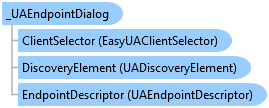

QuickOPC User's Guide and Reference
_UAEndpointDialog Interface


'Declaration<CLSCompliantAttribute(False)> <ComVisibleAttribute(True)> <GuidAttribute("3BD24237-FB61-4891-8627-EF6A71D29C87")> <InterfaceTypeAttribute(ComInterfaceType.InterfaceIsDual)> Public Interface _UAEndpointDialog
'UsageDim instance As _UAEndpointDialog
[CLSCompliant(false)] [ComVisible(true)] [Guid("3BD24237-FB61-4891-8627-EF6A71D29C87")] [InterfaceType(ComInterfaceType.InterfaceIsDual)] public interface _UAEndpointDialog
[CLSCompliant(false)] [ComVisible(true)] [Guid("3BD24237-FB61-4891-8627-EF6A71D29C87")] [InterfaceType(ComInterfaceType.InterfaceIsDual)] public interface class _UAEndpointDialog
// This example shows how to let the user browse for an OPC-UA server endpoint. #include "stdafx.h" // Includes "QuickOpc.h", and other commonly used files #include "ShowDialog.h" namespace _UAEndpointDialog { void ShowDialog1::Main() { // Initialize the COM library CoInitializeEx(NULL, COINIT_MULTITHREADED); { // _UAEndpointDialogPtr EndpointDialogPtr(__uuidof(UAEndpointDialog)); // EndpointDialogPtr->DiscoveryHost = L"opcua.demo-this.com"; // DialogResult dialogResult = EndpointDialogPtr->ShowDialog(NULL); _tprintf(_T("%d\n"), dialogResult); if (dialogResult == 1/*OK*/) { // Display results _tprintf(_T("%s\n"), (LPCTSTR)CW2CT(EndpointDialogPtr->DiscoveryElement->ToString)); } } // Release all interface pointers BEFORE calling CoUninitialize() CoUninitialize(); } }
// This example shows how to let the user browse for an OPC-UA server endpoint. class procedure ShowDialog.Main; var EndpointDialog: OpcLabs_EasyOpcForms_TLB._UAEndpointDialog; DialogResult: System_Windows_Forms_TLB.DialogResult; begin // Instantiate the dialog object EndpointDialog := CoUAEndpointDialog.Create; EndpointDialog.DiscoveryHost := 'opcua.demo-this.com'; DialogResult := EndpointDialog.ShowDialog(nil); WriteLn(DialogResult); if DialogResult <> DialogResult_OK then Exit; // Display results WriteLn(EndpointDialog.DiscoveryElement.ToString); end;
Rem This example shows how to let the user browse for an OPC-UA server endpoint. Private Sub ShowDialog_Main_Command_Click() OutputText = "" Dim EndpointDialog As New UAEndpointDialog EndpointDialog.DiscoveryHost = "opcua.demo-this.com" Dim DialogResult DialogResult = EndpointDialog.ShowDialog OutputText = OutputText & DialogResult & vbCrLf If DialogResult <> 1 Then ' OK Exit Sub End If ' Display results OutputText = OutputText & EndpointDialog.DiscoveryElement & vbCrLf End Sub
Rem This example shows how to let the user browse for an OPC-UA server endpoint. Option Explicit Const DialogResult_OK = 1 Dim EndpointDialog: Set EndpointDialog = CreateObject("OpcLabs.EasyOpc.UA.Forms.Browsing.UAEndpointDialog") EndpointDialog.DiscoveryHost = "opcua.demo-this.com" Dim dialogResult: dialogResult = EndpointDialog.ShowDialog WScript.Echo dialogResult If dialogResult <> DialogResult_OK Then WScript.Quit End If ' Display results WScript.Echo EndpointDialog.DiscoveryElement